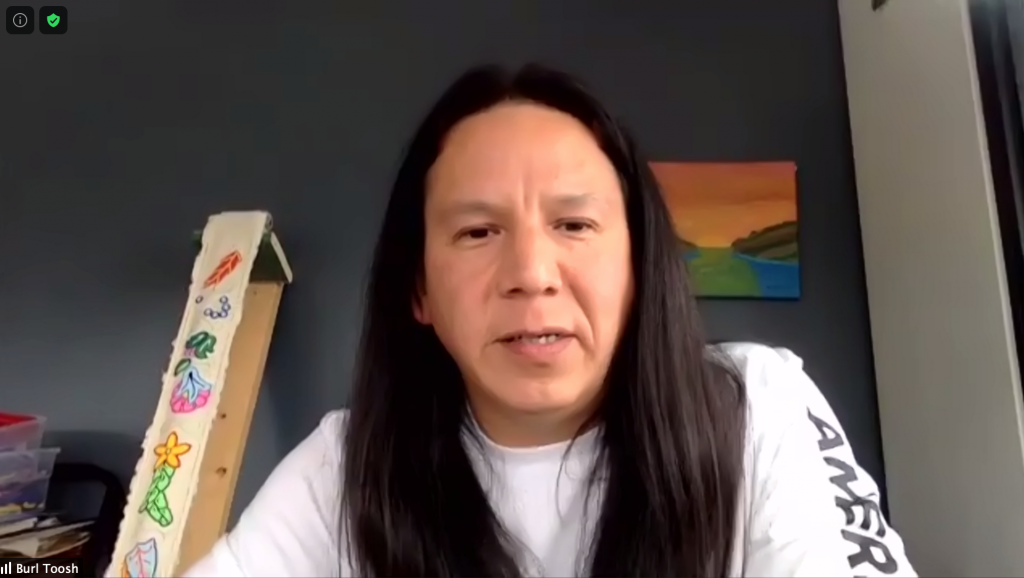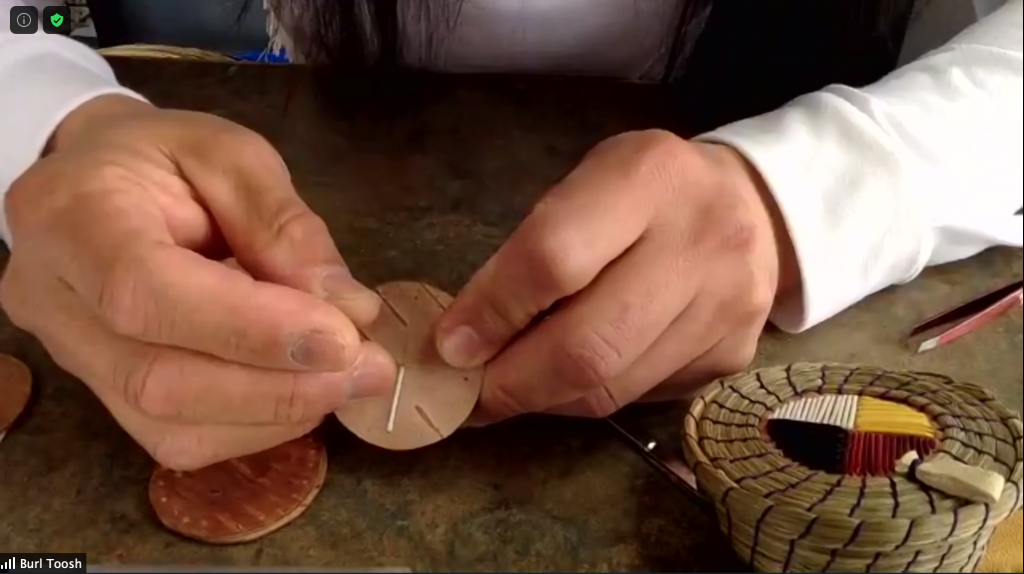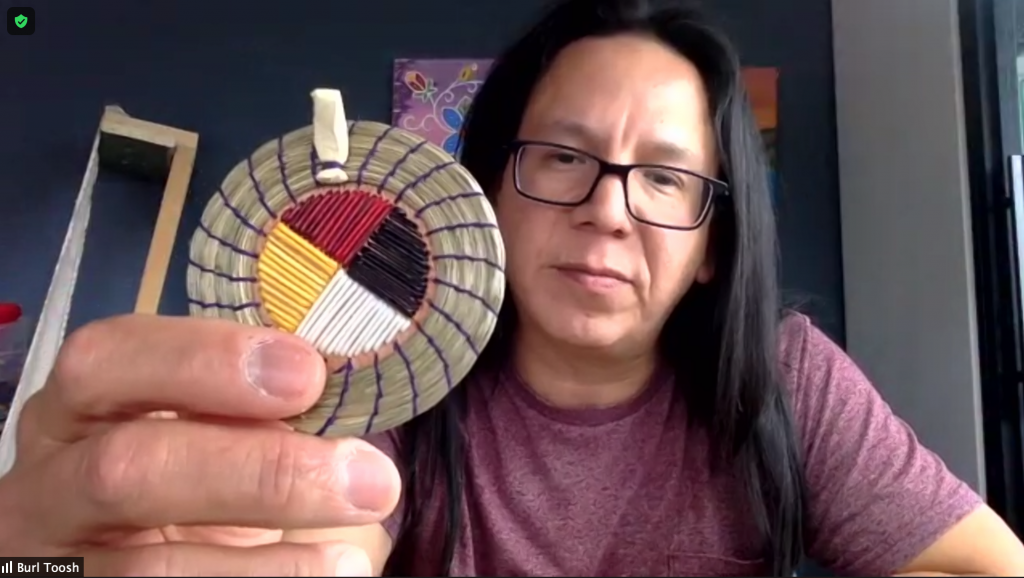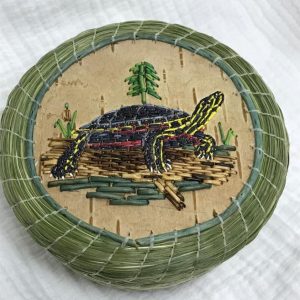
Quillwork by Burlington Tooshkenig
This weekend I was lucky enough to attend a Two-Spirit basketweaving workshop. The event was hosted by First Light, Trans Support NL Inc., and Coastal Health NL. It is a 2 day basket weaving class taught by Burlington Tooshkenig. He grew up on the Walpole Island First Nation, a member of the Potawatomi, and is now living in Newfoundland within sight of the ocean. Burl has an online store (Sweetgrass & Cinnamon – Indigenous Art) selling gorgeous quillwork, baskets, jewelry, and more if you’d like to explore his creations, like the incredible image of the turtle on the right.
I love the smell of sweetgrass. It smells of green and gold simultaneously. Please don’t make me explain the smells of colours, that sentence makes perfect sense inside my head. Many scents have colour associations for me. If I were to design the perfect meditation room, it have Japanese-style tatami mats on the floor, but they would be made all of sweetgrass, so that every time we stepped or knelt on them, the scent would be released into the air. When I opened the box of supplies for the workshop, the first thing that hit me was the smell of the sweetgrass. When it it fills your lungs, it feels like everything in the world is right again. It is the smell of cleanliness and purity. Thank you Burl, for assembling the kit, and Kathy, for shipping the kit. Seriously: just opening the box was a gift.
I’d like to highlight something important here: Burl is teaching these classes to make sure that these skills don’t die out. At one point, there were only five people in his community still doing this type of sweetgrass basket making. Today, none of those five are still with us, making baskets, and I think it that has added a sense of urgency. We need to share these lessons with our children, our families, and our communities. Burl is quite unusual in that he is open to teaching non-indigenous students. Many elders prefer to keep their culture insular, only sharing it with those close to them, sometimes not even teaching those outside their immediate bloodline. While I understand the desire to protect ancient medicine, it leaves us at constant risk of knowledge being lost forever. All it takes is one generation of children who cannot or will not carry on the traditions, and they are lost. Burl has taken a different approach. He described the class we were taking as something akin to building bridges to other communities, so that we can learn to appreciate each other and value each other. I think that this is important… the more we know about each other, the harder it is to find reasons to hate and fear. During the two days of this course, we got to see participants on either coast of Turtle Island, plus some of the spaces in between, share in the creation of art while sharing stories about their lives and families.
Burl lost some of his language use in child protective services where it was sternly frowned upon. His grandmother helped him recover his language. She refused to speak to him in English, which seems stubborn, but was probably for the best. She took him on walks, teaching him medicine in the bush. Through persistence, telling him story after story, she helped him recover his language and his relation to it. To this day, when he goes out looking for things like orange jewelweed for its medicinal properties, Burl can hear snippets of her stories as he walks in the bush. As he shared stories with us, and we shared stories with each other, connections were made across space and time. We have so much in common, even at different ages and in different territories.
Burl isn’t the only one having challenges retaining ties to the language and culture. Many elders were broken of the habit of speaking their native tongues for fear of punishment. Some children were raised by adoptive parents, or outside of the residential communities, making it hard to hear the language as a living thing. Some of the students of this class were finding online courses across Canada to try and forge some new links in the chain. We heard the challenges associated with trying to be recognized, struggling against government rules or other family members who wanted not to be bound to the indigenous life. Language changes how you perceive the word… as you travel around the world, you will find that whether or not a culture has a word for a given concept will shape how they think about that concept, if at all! When we lose words, we lose unique ways of thinking about the world around us and how to interact with it.
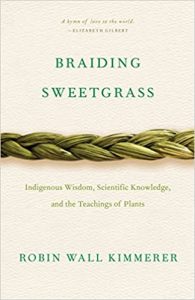 Speaking of words… sweetgrass is called welim’qewe’l (wel·che·mach·ke·weel) in Mi’kmaq. If you want it in a sentence, it would go like this: Weljemajgewe’l najimawo’tune (let’s go gather sweetgrass). Sadly, it is much easier for me to give pronounce the scientific name (Hierochloe odorata). Either way, it is a fragrant grass with long, satiny leaves. The name Hierochloe odorata is from the Greek and Latin. Hierochloe means “holy grass” and odorata means “fragrant”. It is well known to many Indigenous people in Canada and the United States as a material for baskets, as well as a scent, medicine and smudge. If you would like to learn more, I encourage you to try reading Braiding Sweetgrass: Indigenous Wisdom, Scientific Knowledge, and the Teachings of Plants. It is a 2013 nonfiction book by American professor Robin Wall Kimmerer and published by Milkweed.
Speaking of words… sweetgrass is called welim’qewe’l (wel·che·mach·ke·weel) in Mi’kmaq. If you want it in a sentence, it would go like this: Weljemajgewe’l najimawo’tune (let’s go gather sweetgrass). Sadly, it is much easier for me to give pronounce the scientific name (Hierochloe odorata). Either way, it is a fragrant grass with long, satiny leaves. The name Hierochloe odorata is from the Greek and Latin. Hierochloe means “holy grass” and odorata means “fragrant”. It is well known to many Indigenous people in Canada and the United States as a material for baskets, as well as a scent, medicine and smudge. If you would like to learn more, I encourage you to try reading Braiding Sweetgrass: Indigenous Wisdom, Scientific Knowledge, and the Teachings of Plants. It is a 2013 nonfiction book by American professor Robin Wall Kimmerer and published by Milkweed.
The little basket we were making had a small birch bark base and lid. The sides were made of braided sweetgrass, stitched together with sinew. The lid had a porcupine quill design in the shape of a medicine wheel. In case you’re wondering about scale, it is only about an inch and a bit across the base of the basket. This is a small, delicate art, requiring some actual dexterity in your fingers. More on that in a moment.
After collecting porcupine quills, it turns out that not all of them are suitable for embellishment. The ones we were sent were about two and a bit inches long and were dyed. In their natural state, the quills are pale yellow to white with black tips. They need a bit of soaking before being used to soften them up enough to work with. The process is sort of like embroidery with thread, but instead of stitches of thread, you are taking small porcupine quills and poking both ends into holes in birch bark. You need to place your fingers on either side of where the awl comes through, or you will punch holes in your fingers. I can see that this is the kind of thing that my mother would have excelled at. I have trouble keeping even pressure and even distances between stitches. As I watched the rest of the class, I was amazed at how fast some of the students could pick up the skill. If the spaces between the quills was a bit uneven during the first quarter (white), they were already seeing improvements by the second quarter (yellow), and the red and black quarters seems to speed by in no time at all.
To be clear: that’s the other students, not me! Please don’t ask to see pictures of my basket… this is going to take some work. I have a lot of trouble learning from videos, because I need to watch first, then try it. REALLY slowly. Don’t ask me why text information goes in easy, but anything that has a visual and manual aspect to it is so much harder to get into my head and convert it into motion. The other students seemed to take to this like a fish takes to water.
I’m learning a lot about the materials. It turns out that birch bark has some interesting properties. It tends to seal itself when you punch small holes in it, so it grasps the quills in place. You just clip the ends off on the other side of the bark and they stay in place without a knot or anything. After years of looking at these designs, I am realizing for the first time ever that while it looks like embroidery, the needles are almost entirely on one side of the design.
Burl’s hands move with great certainty, guiding each porcupine needle into place. I’m stuck watching in amazement at how very easy he makes it look. As he showed us how to do the basic quillwork, he shared stories with us about his family and past. Traditional arts are constantly in danger of dying out, so he is working with people across the country to keep these skills alive. One of the most fascinating pieces of advice he gave was that we, as students, should work to develop our own style, rather than copy the style of one tribe or one artist. In this way, over time our creations would not just sustain the art, but add to the body of expression. If we just repeat the styles of the past, we don’t grow and evolve as people. This is a very different take on things, and one that I love. It is important to remember that indigenous communities are modern-day people, not a museum. While it is important to retain the past, it needs to be built upon continuously by the living members, taking the traditions into a contemporary space as well as showing that the people have a future.
If you’d like to learn more about Burl, click here to read this article over at CBC News (Nestled by a Newfoundland bay, this man is fighting to keep an Indigenous tradition alive).
I am grateful to all of the people who made this class possible. I appreciated my fellow students, who shared their stories while they stitched the grass into place. I am especially thankful for the time that Burl gave us, trying to create a new generation of sweetgrass basket weavers. While I might not be terribly good at these things, it meant a lot to be able to be even a small part of such an event.
Wela’lin / thank you.
